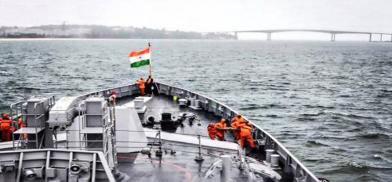Indian Navy keeps vigil from Himalayas to Straits of Malacca
From the icy heights of Ladakh in the Himalayas to the deep waters of the Malacca Strait, the Indian Navy has increased deployment since the stand-off with China, officials with knowledge of the development said

From the icy heights of Ladakh in the Himalayas to the deep waters of the Malacca Strait, the Indian Navy has increased deployment since the stand-off with China, officials with knowledge of the development said. The Long-Range Naval Surveillance Aircraft US-made P8i maintains almost round the clock watch over Northern Ladakh whereas warships maintain vigil of the whitewater shipping movement to and from China.
In the last decade, Indian Navy has transformed it from groundwater navy to bluewater adding logistics, tankers which are further strengthened by regional cooperation to sustain deployment far away from the shores around the year.
Deployment of warships has been increased by 25 percent since the border-tensions started. "Almost all warships are out," a second senior official who didn't want to be named citing rules for speaking to media said.
In addition, the Indian Navy is operating from the Ladakh in the North to Mauritius, 7,000 kilometres to the South; and from the Red Sea in the West to the Malacca Strait in the East, a distance of nearly 8,000 kilometres.
The Indian Navy deploys ships on Mission-Based Deployments at key locations in the Indian Ocean Region so as to build a comprehensive maritime picture and respond to developing situations.
At any time, there are warships patrolling the Bay of Bengal, Malacca Strait, Andaman Sea, Southern Indian Ocean Region, Central Indian Ocean Region, Gulf of Aden and the Persian Gulf.
Additionally, following maritime security incidents, a combat-ready warship has also been deployed on Operation Sankalp since June 2019 for protection of Indian merchantmen passing through the Persian Gulf.
Being a network-enabled force, the Navy maintains total awareness of the Indian Ocean Region by using the IFC-IOR (Information Fusion Centre - Indian Ocean Region), ships on Mission Based Deployments, P-8I and Dornier surveillance aircraft and other high-end surveillance tools.
Near-coast surveillance is also coordinated by the Indian Navy by coordinating the resources of nearly 20 government agencies to draw an electronic fence over our coastline, to deter any 26/11 type incident.
"A good Navy is not a provocation to war. It is instead the surest guarantor of peace," said a senior Indian Navy Officer.
This famous axiom regarding Navies aptly describes the current conundrum of a two-front conflict facing India, even as the nation battles the Coronavirus pandemic.
Coordinated approach
As the irredentist actions of the Chinese Communist Party's Army increased in the months of May and June, culminating in the martyrdom of 20 gallant soldiers on June 15, reports indicate that the service chiefs of the Indian Army, Navy and Air Force were meeting on a daily basis to coordinate the joint response.
P8I Poseidon aircraft deployment
While the Indian Army mobilised on a war-footing in Ladakh and other areas along the LAC, the Air Force forward-deployed its top-of-the-line aircraft. The Indian Navy deployed the P8I Poseidon aircraft to Ladakh to provide valuable intelligence on Chinese Communist Party's Army mobilisation across the Line of Actual Control.
Aptly named after the Greek God of the Sea, the P8I is an all-weather aircraft with latest sensors and weapons, and is a maritime domination platform.
The cutting-edge performance of the aircraft has now prompted the Indian Navy to place orders for another 10 of these aircraft, which will soon increase its inventory to 18.
MiG-29K induction
The Indian Navy is now set to induct the carrier-borne strike aircraft MiG-29K to fly combat air patrols along with Indian Air Force jets in Ladakh - a credit to the joint pilot training programme of the Indian Armed Forces.
Strategic engagements
The Indian Navy was at the forefront of strategic signalling to the Chinese Communist Party during the past months. Signing of the Mutual Logistics Support Agreement in June with Australia gave Indian Navy access to the strategically located Cocos Keeling Islands in the Southern Indian Ocean, which will enable ships and aircraft to keep watch on Chinese Communist Party Navy ships and submarines entering the Indian Ocean Region.
Similarly, the Agreement provides Australian ships and aircraft access to the Andaman and Nicobar Islands, to extend their reach into the South China Sea.
Joint exercises
The Indian Navy conducted four joint exercises with foreign Navies during the Galwan crisis to signal intent to the Chinese Communist Party Navy. The India-Indonesia coordinated patrol was conducted along the maritime boundary line on June 15 by ships and aircraft of both nations, while Japanese and Indian Navy ships also jointly exercised in the Indian Ocean Region on June 27. Passage Exercises were also conducted with French Naval ships in June and between the Indian Navy's Eastern Fleet and Nimitz Carrier Strike Group in July.
These joint exercises were an affirmation of the resolve of the global comity against the Chinese Communist Party's recent aggressions. The combination of joint-resolve on the LAC coupled with strategic signalling at sea seems to have had the desired effect, for now.
With the disengagement at Ladakh slowing down, the Indian Armed Forces are aware that this could be long drawn-out affair. Adequate operational-tempo tempered with the maintenance of readiness of men and materiel is the order of the day.
Maritime dimensions of strategic jousting by the CCP may also bring the CCP Navy head-to-head with the Indian Navy, a fact that strategists and planners in South Block are well aware of. (IANS)








Post a Comment